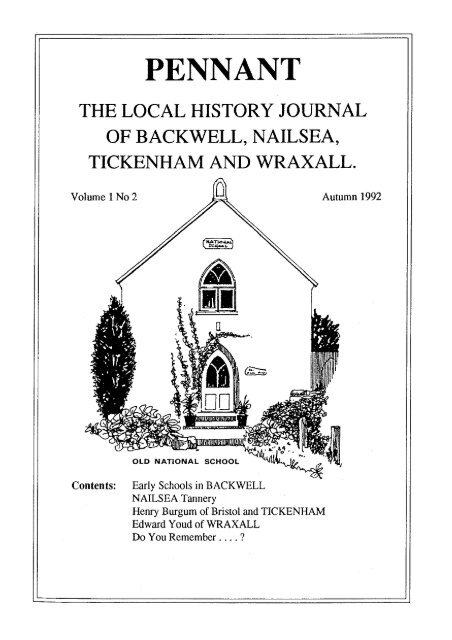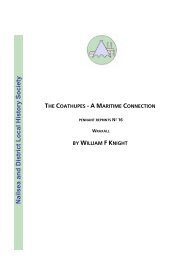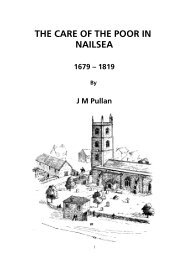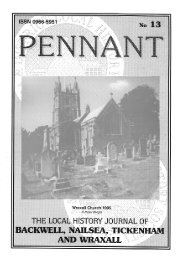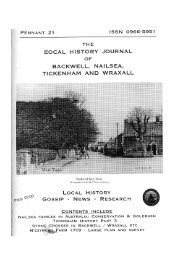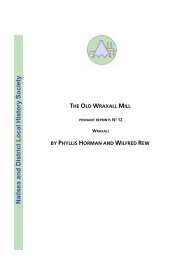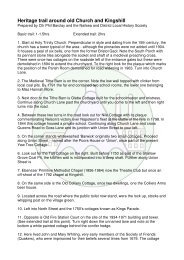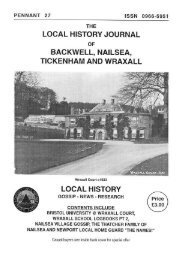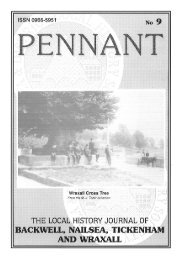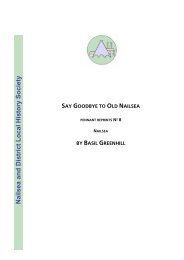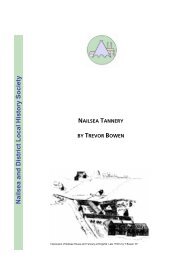No 2 - Nailsea and District Local History Society
No 2 - Nailsea and District Local History Society
No 2 - Nailsea and District Local History Society
You also want an ePaper? Increase the reach of your titles
YUMPU automatically turns print PDFs into web optimized ePapers that Google loves.
Previously published by <strong>Nailsea</strong> & <strong>District</strong> <strong>Local</strong> <strong>History</strong> <strong>Society</strong>during 1992.This ebook version, © The respective authors <strong>and</strong> <strong>Nailsea</strong> &<strong>District</strong> <strong>Local</strong> <strong>History</strong> <strong>Society</strong>, PO Box 1089, <strong>Nailsea</strong> BS48 2YP,has been made available in October 2007, so that an individualmay download <strong>and</strong> read this document, for private researchpurposes only. It must not be reproduced or passed to a thirdparty without written permission of the copyright holders.2
Early Schools in Backwellby <strong>No</strong>rma KnightThe earliest surviving reference to a school in Backwell occurs in1744 when a schoolroom was being hired in Farleigh for 6d aweek. Payments at that rate were made by the Overseer for thePoor at irregular intervals throughout the 18th century. At firstthe schoolroom may have been at Farleigh Inn (later The George)as the earlier payments were made to John Woodall who wasl<strong>and</strong>lord of the inn. Mary Butcher <strong>and</strong> Mr Barnes were also listedas receiving money "for the schoolroom", although it is possiblethat they were teachers working in their own cottages. Certainlyby 1787 the school was being held in property owned by SirCharles Kemys Tynte. As well as the school house there was anorchard <strong>and</strong> a house lying south of the Turnpike Road (nowA370) at Farleigh. The cottage survives, lying next to the pathleading from the main road to Uncombe Close.The first teacher about whom anything is known in detail wasThomas Butt. He arrived in Backwell about 1766 from Bisley,Gloucestershire, where he said he had lived for about 20 years<strong>and</strong> where he possessed two houses <strong>and</strong> an acre of ground. Hehad a wife, Ann, <strong>and</strong> a son, Thomas, baptized in Backwell on 13October 1769. However, when baby Thomas was six months oldhis father applied for assistance to the Overseer. He was alreadyteaching but apparently not paid sufficiently well to supporthimself <strong>and</strong> his family. In 1769 he had fallen behind in hispayment of the highway rate but eventually made it up. TheOverseer received his application with sympathy <strong>and</strong> it wasagreed that he should have 2 guineas a year. The Butt familyremained in the parish for a further 20 years. In March 1790 theOverseer allowed Thomas Butt a garment, <strong>and</strong> although it is notclear whether this was for the father or son, the family wereobviously not entirely self-supporting. Thomas Butt senior had3
died by July 1791 when his widow received one guinea from alegacy of £5-10-6d left to her by a benefactor. Following ThomasButt, the Overseer's accounts record payments in 1794 <strong>and</strong> 1796to George Burnett of "18s for schooling".These early references to a school indicate that it was a smallestablishment typical of parish schools of that period, funded outof the rates <strong>and</strong> by charitable bequests. Education was of themost basic kind, as is made clear by the will of Charles Wilcox ofWest Town. In 1783 he left 50 in trust. Half the interest was toprovide bread for the poor of West Town to be distributed twiceyearly in February <strong>and</strong> December, but the other half was for "theeducation the English language" of poor children of West Town.In 1809 the capital sum was used to buy a piece of l<strong>and</strong> onBackwell Common which was then let at 50s a year, but againhalf of that income was put towards the cost of educating thepoor children from West Town. In 1815 Hannah Merrick received£1-5-0 for "1 year's schooling for 3 children", <strong>and</strong> a similaramount went to Ann Moore in 1816, "left by the late Mr Wilcoxof West Town". Those children attended the school at Farleigh.Two years later, in a report to The Select Committee on theEducation of the Poor, the Curate stated that in Backwell, with apopulation of 593, there was one small school taught by onewoman, containing 7 or 8 children. He added that "the poorhave not sufficient means of educating their children <strong>and</strong> wouldbe glad to obtain them".The growing national interest in education had led to theestablishment of two rival religious societies for promoting theeducation of the poor. The National <strong>Society</strong>, founded in 1811,advocated education in the principles of the established church,while The British <strong>and</strong> Foreign School <strong>Society</strong> (1814) promotedbible reading but undenominational teaching. Both Societiesused the monitorial system of teaching, developed by AndrewBell <strong>and</strong> Joseph Lancaster, whereby the older pupils taught the4
younger. In Backwell the church took the lead in founding a newschool <strong>and</strong> it was to be based firmly on the National <strong>Society</strong>system.On 16 June 1821 the lord of the manor, the Marquess of Bath,granted the lease of a house at Farleigh, comprising twotenements with gardens <strong>and</strong> an adjoining building, which hadbeen in use as a Methodist meeting or Chapel, to the Rector,Vicar, <strong>and</strong> Churchwarden in trust. Part of the property was to beconverted immediately "into a school for the teaching <strong>and</strong>instruction of the children of the parish in reading <strong>and</strong> writingagreeable to the system in use called Bell's or the Nationalsystem". The school was maintained by voluntary contributions,weekly payments of 1d. <strong>and</strong> the income from the Wilcox charity.Any surplus funds were to be used for the benefit of the school.By 1833 the school was well established. An enquiry in that year,published in 1835, reported that there were 62 boys <strong>and</strong> 38girls. The schoolmaster <strong>and</strong> mistress (usually husb<strong>and</strong> <strong>and</strong> wife)had a joint salary of 40 a year with a house <strong>and</strong> garden. It wasthe largest but not the only school in the parish.Elsewhere there was an infants' school with 9 boys <strong>and</strong> 11 girls,paid for by their parents, <strong>and</strong> 3 other schools with about 15 boys<strong>and</strong> 15 girls, also educated at their parents' expense. In additionthere were three Sunday schools in 2 of which there were 63boys <strong>and</strong> 51 girls who attended the parish church. The otherSunday school, started in 1831, was run by the WesleyanMethodists <strong>and</strong> had 37 boys <strong>and</strong> 29 girls. All the Sunday schoolswere free. It would seem that by the mid 1830s the dem<strong>and</strong>forelementary education was being met, although it is impossibleto say how adequately.The National school at Farleigh continued to provide instructionfor the majority of the children. Among the staff were Thomas5
Holbrook, master in 1843, <strong>and</strong> Mrs Cole, who was the last toteach in that schoolroom. The building which survives as ahouse, was near the green, south of the main road. Accounts ofrepairs are recorded from time to time. In 1843 the gate wasgiven a new rail <strong>and</strong> bars, a latch <strong>and</strong> posts; a new windowframe was inserted <strong>and</strong> the kitchen ceiling (probably in themaster's house) was refurbished. Other equipment providedincluded a picture frame <strong>and</strong> flags. These, together with paint,timber, nails <strong>and</strong> labour, cost £2-8-7d. In 1857 the thatchneeded attention. By the late 1850s the premises were becomingtoo small <strong>and</strong> were unfit for use. The lease on the Farleighbuilding was finally surrendered on 2 December 1861 <strong>and</strong> theMarquess of Bath contributed £140 towards the erection of anew school in Church Town which opened the following year.SourcesBackwell Parish Records (mainly in the Somerset Record Office)S.R.O., D/D/Rt 395. Tithe Award 1843Surveys of the manor of Backwell, 1787, 1812, 1837. LongleatW.M.R. Quoted by permission of the Marquess of Bath.Charity Commissioners' Reports. Somerset 1820-1837Digest of Returns to Select Committee on Education of the Poor,H.C.224(1819)ix(2) p.772.Education Enquiry Abstract, H.C.62(1835)xlii p.791.6
<strong>Nailsea</strong> Tanneryby Trevor BowenPart 2. Excavation <strong>and</strong> Provisional Reconstruction.Looking at the process for converting skins into leather (Part 1) itis obvious that large quantities of clean, preferably running waterwere needed for the cleaning of the skins <strong>and</strong> mixing of thetannin liquor.Could the need for this plentiful supply of water havedetermined the location of the tannery at Kingshill?For much of the year there was no shortage of water in any lowlying area of the village, so surely the name "Watery Lane"indicates an additional source. Even today the stream whichsome say originates near <strong>Nailsea</strong> School still runs beneath theroad, <strong>and</strong> glimpses of it can sometimes be seen between thepavement slabs.When houses were built on the site in 1985, the <strong>Nailsea</strong> <strong>and</strong><strong>District</strong> <strong>Local</strong> <strong>History</strong> <strong>Society</strong> retrieved the remains of a h<strong>and</strong>pump from the roadside, <strong>and</strong> there were two lengths of castpipe similar to those used for pumping water from coal mines.We have no date for the bridging over of the stream <strong>and</strong>surfacing of Watery Lane as we know it. For the record whenSouth West Gas dug a trench in May 1992, David Chappell tookphotographs of asection outside <strong>No</strong> 2 Watery Lane <strong>and</strong>measurements indicated that the underside of the pennant slabsused to bridge the culvert were some 21 inches below thesurface.7
Oak bark needed for the making of the tannin liquor was mostlikely brought from the Wyeside forests via Chepstow* since by1799 over 9000 tons annually were being shipped from thatport. (* see "Leather <strong>and</strong> Oak Bark at Chepstow" Chepstow<strong>Society</strong> 1980)In 1985 when <strong>Society</strong> Members kept a watching brief on thesite, ten of the process pits were broken into on the line of thehouse foundations (Fig.1) Generally these measured 8x5x5 feetdeep, approximating to those of the Rheadr Tannery re-erectedat the St. Fagans Welsh Folk Museum. Most were lined in brickor coursed pennant stone; one was rendered over stone <strong>and</strong> stillretained water; one was partly timber lined. Further masonry wasencountered in the fifty foot interval between the groups of pitsbut this area was not excavated by the builders.During site levelling, three mill stones were uncovered, two ofwhich (Fig.2) were removed by the <strong>Society</strong> <strong>and</strong> now st<strong>and</strong> besidethe drive to <strong>Nailsea</strong> House. They comprise a pair of stones, iebedstone (lower) <strong>and</strong> runner (upper), which may have been usedto grind bark using horse power.Based on speculation by the present owners of the tworemaining oak bark tanneries at Colyton <strong>and</strong> Grampound, anannual usage of about 6 tons of bark has been arrived at for atannery employing a maximum of twelve men (1851) <strong>and</strong> havingpossibly 25-30 pits. <strong>No</strong>r is the output of leather easily estimated,for although the process of bark tanning remains basicallyunchanged, mechanisation has greatly increased productivity <strong>and</strong>skins are now bought in already de-haired <strong>and</strong> fleshed. Howeverthe owners surmise that a weekly output of some 20/25 hideswould be a reasonable assumption.From the evidence available, a provisional reconstruction of thetannery can be attempted.8
A small oak bark tannery of some 25 pits operated from the late17th century or earlier until the 1880s. Skins of cattle <strong>and</strong> horseswere brought from the surrounding area, <strong>and</strong> after a process oftanning lasting up to 18 months or even more, the resultingheavy leather was sold locally for the making of boot soles <strong>and</strong>uppers, harness, colliery buckets, engine drive <strong>and</strong> transfer belts<strong>and</strong> other industrial, agricultural <strong>and</strong> domestic uses requiringstrong <strong>and</strong> durable heavy leather. About 25 hides per week wasthe likely output. The tannery <strong>and</strong> village supported a significantboot, shoe <strong>and</strong> clog industry of some 11- 33 persons over the1841 - 1881 census period, although these were likely to havebeen outworkers not centred upon a workshop.A visitor would be aware of a stillness that was tranquil if notoppressive. Men would work in pairs drawing hides from one pit,loading them onto a h<strong>and</strong> trolley <strong>and</strong> depositing them intoanother. When a pit was topped up with stronger liquor, thebrown liquid ran along an inclined wooden trough which couldbe moved about as required. Water for the initial <strong>and</strong> finalwashing of the hides, <strong>and</strong> for the mixing of the tannin liquor <strong>and</strong>slaked lime, was pumped from a stream which flowed alongside.The silence would occasionally be broken by the barking of a dogor the scratching of a rat. Infrequently the mill was started up<strong>and</strong> the plates of bark fed into the revolving cutters. Fine dustwould fly everywhere. Some newly delivered skins could be seenpegged to the ground for the mastiff dogs to bite off the fats.Even more noticeable than the silence was the smell which couldnot easily be described; not of leather but of bark <strong>and</strong> tannin. Itpermeated the clothing <strong>and</strong> would linger with the visitor until hereached home <strong>and</strong> bathed his body <strong>and</strong> discarded his clothes.Mr Ivor Grimsted of Whitchurch (Bristol) has made a study of theBedminster tan yards <strong>and</strong> I am grateful to him for the following9
information on the Cox family <strong>and</strong> its involvement with the<strong>Nailsea</strong> yard:-James Fitchew Cox was born in 1807, the second son ofStephen <strong>and</strong> Martha Cox of Court de Wyck, Claverham. In 1833he married Ann White, both of them by then residents of<strong>Nailsea</strong>, <strong>and</strong> by 1836 James was referred to as "tanner of LongAshton". A year later he took out a patent with a WilliamHarepath for "a roller <strong>and</strong> belt process".By 1839 he was living at <strong>Nailsea</strong> House - previously occupied byJohn Tanner, leather merchant <strong>and</strong> tanner of Bristol. Jamesentered into partnership with his brother Stephen <strong>and</strong> by 1842the business was registered as J & S COX (Patent Roller <strong>and</strong> BeltProcess). In the same year Stephen built a tannery at Court deWyck. James died in 1852 aged 45, but his brother who lived inGoss Lane Cottage (<strong>Nailsea</strong>) continued the family business. It islikely that he moved into <strong>Nailsea</strong> House following James' death,he was certainly living there from 1857 onwards.The business was styled COX BROS with the main yard atBedminster <strong>and</strong> smaller concerns at Ashton, Yatton <strong>and</strong> <strong>Nailsea</strong>.Stephen retired in 1877. In 1878 the Bedminster yard wastaken over by Thomas Ware who today trades as Thomas Ware<strong>and</strong> Sons, Clift House Tannery, the only survivor of the eighttanneries in the Bedminster area of Bristol.With only two workers recorded in the 1881 census, we canassume that the <strong>Nailsea</strong> yard was all but closed.10
William McEwen-Smith's son Eric was born in the house, <strong>and</strong> stilllives in Tickenham. As a youth he can remember his fathertriumphantly coming home one day to say that he had made thefinal payment, <strong>and</strong> the place was his.Eric can also remember seeing dates of around 1760 cut into thelead on the roof; so that could suggest that the house had beenbuilt by then. In one part of the cellars, there is a glazed windowin what was the outer wall, but then had a wall against it whichwas part of a catchment tank for rainwater from the roof. Thisserved the household for some time, as mains water did notreach the village until 1921, though some Estate houses wereserved some thirty years earlier.Water is of course a most important factor in the running of afarm carrying livestock, <strong>and</strong> a policeman of before the first worldwar called Duck was a proficient water diviner. He thought thatwells at Hale's Farm, Wellhouse Farm, Batch Farm <strong>and</strong> LuggardsCross Farm were all fed by an underground stream starting froma spring on the ridge to the north. One of the Hale's Farm wellswas over 100 feet (30 metres) deep <strong>and</strong> cut into sheer rock afterthe first few feet.<strong>No</strong>t long after the second world war, the local historian GrayUsher ("Moorman" of the Mercury) with some archaeologistsfound the foundations of some sort of foundry on Mog's Groundjust above the house. <strong>No</strong>w Henry Burgum was a pewterer, <strong>and</strong>worked with other metals. Have we come back to the beginningagain?(With acknowledgements to Mr <strong>and</strong> Mrs E McEwen-Smith. Forfurther background see "The Making of A Manor" (Forrest)).12
Edward Youd of Wraxall;Drowned off Cherbourg 1880by David Youd(Here we have a story of the circumstances surrounding thedeath of a local man told at some length. David's orderedapproach <strong>and</strong> the information so gained is a valuable lesson toothers embarking on researches into both local <strong>and</strong> familyhistory. Editor)Edward Youd the youngest son of William <strong>and</strong> Harriet Youd ofWraxall was drowned off Rock Rozel on the coast of France on3rd March 1880. He is commemorated on a grave stone in thechurchyard of All Saints, Wraxall. (Also mentioned on the stoneare his mother who died 20 Mar 1875 aged 57, his brotherJames aged 22 years <strong>and</strong> his father who died 18 March 1895aged 75).I wondered, when I first saw the stone, what Edward was doingto be drowned in the English Channel. After 60 years I had timeto discover the circumstances of his death. The purpose of thisarticle is to explain how it was done.A visit to St Catherine's House in London <strong>and</strong> an examination ofthe Marine Death Registers showed that Edward was serving onthe Edward P Bouverie when he died. Other entries revealed thatEdward was not alone <strong>and</strong> that eleven others died at the sametime. It was deduced from this that the vessel had most probablybeen wrecked <strong>and</strong> that Edward had not fallen overboard.The deduction was proved right when his death certificate wasobtained <strong>and</strong> revealed that Edward Youd Apprentice wasdrowned when the vessel was wrecked on 3rd March 1880. Avisit was made to the Public Record Office (PRO) at Kew to13
examine papers relating to seamen apprentices, where under refBT156/46 it was found that Edward Youd when aged 17 wasbound apprentice to Cummins <strong>and</strong> Co of Bristol on 4th August1877 for a period of four years.A register of effects of sailors that died at sea is indexed underref BT 150/20 f 32. It was found that Edward was drowned at aplace called Rozel on 3 Mar 1880. This information had beensent to the Board of Trade with a note to the effect that hisaccount was in credit to the sum of £11-16s-3d.Lloyd's List was the next source to be consulted <strong>and</strong> three entriessummarised below were found, all emanating from Cherbourg:4/5 Mar 1880 A British barque out of Bristol foundered afterstriking a rock at Rozel. Crew supposed drowned. The barquewas the Edward P Bouverie with a cargo of sugar.9 Mar 1880 The Edward P Bouverie (Captain Evans) fromSamarang <strong>and</strong> Lisbon previously reported wrecked 21 miles SWof this port. Dismasted <strong>and</strong> disabled prior to str<strong>and</strong>ing, fourbodies <strong>and</strong> thous<strong>and</strong>s of empty baskets <strong>and</strong> many bundles ofrattan have come ashore.3 Apr 1880 The wreck had been sold <strong>and</strong> nothing of the cargosaved.More information was found about the events leading to thewreck in the abstract of returns of Sea Casualties made to theBoard of Trade 1879-1883. These showed that on 3 March 1880the Edward P Bouverie of 941 tons <strong>and</strong> A1 at Lloyds was carryinga cargo of sugar to Havre from Samarang in Java when she wasdriven ashore by a force 6 wind from ENE at Rozel Point. Thecrew of 19 lost their lives.14
To obtain more background information it was decided to lookat newspaper reports <strong>and</strong> by consulting Palmers Index to theTimes newspaper two letters were found that had beenpublished concerning the wreck.The first of these from Mr H P Vereker the British Consul inCherbourg was dated 23 March 1880. In it he stated that all 19bodies had been recovered <strong>and</strong> after religious ceremonies hadbeen decently buried in his presence in the cemetery atSurtainville. Identification <strong>and</strong> indications had been taken fromthe bodies before they had been buried in marked <strong>and</strong> individualgraves.The second letter was dated 3 April 1880. It was from Cummins<strong>and</strong> Co of Bristol who expressed their thanks to Mr Vereker forhis work at Surtainville.It is assumed from these documents that when the Edward PBouverie entered the English Channel to sail to Havre theweather conditions were such that the Captain could not fix hisposition <strong>and</strong> he was unable to round the Cherbourg Peninsula.He would have been driven south west by the prevailing winds torun aground on Rock Rozel opposite Jersey where all 19members of the crew were drowned.CorrespondenceThe first issue generated a lot of comment. <strong>No</strong>w that we havecorrespondents a space will be allocated in each issue for letters,questions <strong>and</strong> answers. We welcome letters on anythingpertaining to <strong>Local</strong> <strong>History</strong>. If you require a written answer pleaseenclose a self addressed stamped envelope.15
We will try to deal with simple family history enquiries relating tolocal families. When making such enquiries subscribers shouldenclose 3 first class stamps, non-subscribers should enclose 6 firstclass stamps .The article on Richard Baber brought forth an interesting letterfrom Mr Moore of Felton.Richard Baber of Backwell, Clockmaker."I am researching the history of early Somerset clockmakers <strong>and</strong>enclose a few notes that I have about Richard Baber whichperhaps will be of interest”.The earliest record discovered so far is in the Kingston SeymourChurchwardens accounts for 1776 <strong>and</strong> 1777 " Pd Baber for theclock 6-0", then in 1780 "Pd. Baber for keeping the clock clean6-0." He continued to receive 6-0 per year until 1786. During thenext 23 years various people worked on the clock including WmNevitt of Chew Stoke, Joseph Moor <strong>and</strong> Samuel Jeffry until anentry in 1809 " Rich Baber for repairing the Church Clock 12-0".The Long Ashton churchwardens accounts reveal that Bristolclockmakers were usually employed to look after the churchclock but as mentioned in the original article he worked there in1806 <strong>and</strong> 1808.In Wraxall there are three references in 1801, 1802 <strong>and</strong> 1805"To Richard Baber for repairing the church clock", the amountsbeing £2-5-0, 12-0 <strong>and</strong> £1-5-0. Previously Nathaniel Wade hadbeen used, in 1803 we find Joseph Moor again. Moor was alsoused in 1817.At Easton in Gordano Nathaniel Wade was also used from 1759to 1765 being paid sums varying from 2-0 to 13-0 for "Mending16
ye clock" <strong>and</strong> then no maker is named until 1780 when theentry "Richard Baber for the clock 11-0" appears. <strong>No</strong> name ismentioned for six years until "William Bilbie for repairing theChurch clock £4-14-6" is entered.Finally at Yatton in 1791 Richard Baber was paid £5-5-0 (aconsiderable sum for the time) for "repairing the Clocke".It was an irritating 18th century practice to name the eldest sonafter his father. Younger sons would also often name theirsecond son after his gr<strong>and</strong>father. It can be difficult to sort outone from the other. Clearly there must have been several RichardBabers as one was an adult in 1730 <strong>and</strong> another was recorded asworking in 1809. A 79 year working life is unlikely.A 39 year working life was not impossible but perhaps theremight have been two clockmakers of that name. 1776, <strong>and</strong> 1809are only the first <strong>and</strong> last recorded dates, so there could be aRichard Baber, Clockmaker for a much longer period.In any case it was becoming uncommon for anyone to actuallymake a clock. Improved transport links <strong>and</strong> roads that wereusable throughout most of the year had made it economic forclock movements <strong>and</strong> dials to be made in large numbers inBirmingham for distribution throughout the country. The clockscould be assembled locally <strong>and</strong> put in a locally made case withthe sellers name painted on the dial. Brass dials could still beengraved <strong>and</strong> made up in Bristol but might well be attached tobe a Birmingham movement. It is unlikely, faced withcompetition from clockmakers in Bristol <strong>and</strong> other villages, thatRichard Baber was a full time clockmaker. His skill must havebeen appreciated within a limited area but dem<strong>and</strong> would havebeen small. He would be in competition with Wade <strong>and</strong> Moor,also the Bilbies, Nevitt <strong>and</strong> Williams of Chew Stoke <strong>and</strong> at leasttwenty Bristol clockmakers who were working at that time.17
“I hope to publish a book about the clockmakers of Somerset<strong>and</strong> Bristol 1650-1900 next year”.The following is from a letter written to the EDITOR by HenryABBOTT 26 Bendysh Road Bushey Watford :-The SS <strong>Nailsea</strong> Meadow, a Gunner's wartime voyageby Henry AbbottThe NAILSEA MEADOW's displacement was approximately 9,500tons quite a good size for a cargo ship, I am not sure how manycrew members were aboard but there were two R.N. Gunners<strong>and</strong> four army gunners of whom I was one. Our relations withthe crew <strong>and</strong> officers was good.The armament was one 12 pounder which the R.N. operated ifnecessary mounted on the rear of the ship <strong>and</strong> two Oerlikon50mm machine guns mounted on either side of the bridge.Our voyage was from Swansea to Montreal with a cargoofanthracite. We set sail Mid <strong>No</strong>vember 1941. The convoyassembled near the Firth of Clyde <strong>and</strong> the voyage across theAtlantic was uneventful as far as action by the enemy wasconcerned. This was probably because of the bad weather weencountered.When we got near the Canadian coast The <strong>Nailsea</strong> Meadow leftthe convoy <strong>and</strong> sailed to Montreal up the St Lawrence riverwhere we had ten days of freedom while the ship was beingunloaded, <strong>and</strong> cleaned, to receive a cargo of wheat .After this we went back on board the <strong>Nailsea</strong> Meadow <strong>and</strong> shesailed to Halifax, <strong>No</strong>va Scotia to join a convoy forming there.18
Once again we were lucky in that the weather was bad as wesailed a northern route that took us near to Icel<strong>and</strong> to avoidenemy aircraft. Eventually we docked in London.I spent 27 days on board the <strong>Nailsea</strong> Meadow but after 50 years Iregret that I cannot remember much about her(Editor's <strong>No</strong>te - The <strong>Nailsea</strong> Meadow was not the only shipbearing the name of the village. In later editions we shall meetthe SS <strong>Nailsea</strong> Court <strong>and</strong> HMS <strong>Nailsea</strong>).19
Do You Remember...................?1. FARLEIGH before WW2by Vera WaiteThe Bristol to Weston super Mare road was rather dusty <strong>and</strong> didnot look the same as it does today.In the 1920s the road was considerably altered <strong>and</strong> this led tothe high banks being formed on the southern side of the roadbetween the George Inn <strong>and</strong> the Backwell crossroads.She went on to mention Mr King who, about 1912 she believes,built "Bank House" as a butcher's shop. Around the corner wasthe Slaughter House (now The Little Thatch"). Vera remembers,with some regret, that, with many of the other children of thevillage, she used to look over the fence to watch the animalsbeing slaughtered. How times have changed.A few yards along the road <strong>and</strong> probably four years earlierWilliam Harrill who kept "The Fairfield Inn"* built UncombeHouse <strong>and</strong> a blacksmith's shop on the main road. The buildingwhich contained the Blacksmith's shop remains there todaybearing a builder's name plate.William Carter was probably the second Blacksmith to workthere <strong>and</strong> he stayed from about 1914 to the mid 1930s. Veraremembers watching him work <strong>and</strong> is fairly certain that theknowledge she gained would have enabled her to have shod ahorse if she had been given the opportunity. She does rememberbeing allowed sometimes to work the bellows. How manychildren who now attend the nearby school could claim the sameI wonder?20
*"The Fairfield Inn" was the subject of Research Paper <strong>No</strong> 4written by Peggy Harris <strong>and</strong> published by <strong>Nailsea</strong> <strong>and</strong> <strong>District</strong><strong>Local</strong> <strong>History</strong> <strong>Society</strong> in 1988.2. A Wraxall Secret of World War IIby Phyllis HormanKnowing of the Editor's interest in local events that took place inthe period 1939-1945 Phyllis Horman recently asked me if I hadheard the rumour about a secret passage in Wraxall <strong>and</strong> its usein the war to store something secret.I hadn't so she explained.In the Avenue is a large, almost semi circular stone, set at anangle into the bank. There was also a smaller flat stone stickingout at the top. This was the "Devil's Stone <strong>and</strong> Seat". It is veryovergrown now with weeds <strong>and</strong> brambles. Behind the stone issupposed to be a secret passage to either Charlton House orNaish House (now gone). It was in this passage that it wasrumoured "something" was stored.Unfortunately it seems most unlikely that there was a secretpassage. If there was what was stored in it is still an officialsecret.3. Death on the Lineby Clifford KortrightI remember an incident when I was a child. At Four Gables at theend of the house facing about South there is a big bedroom withfour windows. My mother was working in the bedroom when21
we heard an aeroplane which was a very rare thing in thosedays. She sat me on the window ledge so that I could see it. Iwas watching it when all of a sudden my mother said"Look at that train, I think it's going to hit that man on the line!”I looked <strong>and</strong> the train did hit him I saw it knock him down <strong>and</strong>the aeroplane l<strong>and</strong>ed in the field beside the line. It appeared thatthe pilot had been trying to attract the man's attention toindicate that a train was coming but he had failed.Anyway the man's name was Mr Lock from West Town <strong>and</strong> hewas killed in 1920 so I can date that incident.4. A POW returns to <strong>Nailsea</strong>I have had the opportunity to speak to an ex POW who wasrepatriated from Backwell in 1946. He believes that he was in acamp near Brockley. Does anyone remember German POWs in ornear Backwell/Brockley? Enquiries that I have made have failed toproduce conclusive evidence of where they stayed. Was it nearBrockley cross roads as the ex-POW thought?I have been told by Mr Parkes of German POWs being marchedalong the main road.22


